Fiber Optic
-
- Innovation @ URI: The smallest deep-sea system that can provide a livestream video feed Marine Technology, Apr 2021 #21
The answers to many of life's mysteries have been discovered far below the surface of the seas. However, getting to those depths has not been easy. Thanks to a new fiber optic reel system invented by Brennan Phillips, an assistant professor of ocean engineering at the University of Rhode Island, deep-sea exploration is about to get much more affordable and accessible.
Shrinking the SystemHaving worked on large research vessels all over the world, Phillips is well aware of the expense, planning and massive scale involved in deep-sea exploration.
"If you have a large underwater vehicle that you're using, you need several people to run it and a large research vessel to operate it, which is very expensive," said Phillips. "By making the vehicles smaller, the cables smaller and the winches smaller, we can save a lot of money and go more places in the world."
Two years ago, Phillips created a miniature, inexpensive deep-sea camera system called DEEPi. However, he still had to rely on a large research vessel to get it in the ocean. That led to his development of a small deployment system.
"It all comes down to the diameter of the cable," said Phillips. "A cable that is three-quarters of an inch in diameter ends up weighing many tons when you have 4,000 meters of it, which means you need a massive winch to go with it. If you make the cable smaller, everything scales down accordingly."After experimenting with a custom-designed cable that was still too wide, Phillips ended up using something that can be spotted all over Rhode Island in the summertime, a fishing reel.
"I wanted to get to the point where I had a winch that could get me somewhere deep in the ocean, but I could carry it in a suitcase," said Phillips. "An electric fishing reel is essentially a miniature winch and it's available off the shelf."
Collaborating with IndustryHaving solved the scale issue, Phillips' next step was to figure out how a cable small enough to wrap around a fishing reel could transmit data, including video, in real time while underwater.
"We didn't have a cable that size with fiber optics in it for data transmission, so we had to invent it," Phillips said.
Not having the necessary equipment to integrate the fiber optics in the fishing line, Phillips requested the help of Jim Owens, principal of Nautilus Defense in Pawtucket."When I told Jim that I wanted to a make fiber optic fishing line, I thought he would say 'that's impossible' or 'I can't do it,'" said Phillips. "But he surprised me by saying, 'I think we can do that.' A week later he mailed me a prototype."
"Brennan had very clear parameters and objectives for the system and he let us run with our part of the project," said Owens. "We developed a fiber optic tether that was mass and volume-efficient using our in-house braiding equipment."
With the fishing reel and fishing line now at the same scale as the deep-sea camera he previously developed, Phillips successfully produced the smallest, most compact deep-sea system in the world that can provide a livestream video feed.
The fiber optic reel system is described in the April 2021 issue of Sensors. Co-authoring the journal article with Phillips were URI ocean engineering students Nicholas Chaloux and Russell Shomberg; Adriana Muñoz-Soto, who did an internship on the project for the University of Puerto Rico Mayagüez; and Owens.
Phillips and Owens have filed for a provisional patent for the fiber optic reel system, with the application being sponsored by URI and Nautilus Defense.
Putting it to the TestPhillips began working on the fiber optic reel system before the pandemic started, but did the bulk of the testing during the pandemic.
In the summer of 2020, he deployed the system a couple of times in the Narrow River in Rhode Island, where the water was calm and flat. He used his own personal boat for the test. Another conducted another test in Narragansett Bay, near Newport.The first deep-water test took place later in the summer on a day-long boat trip to Atlantis Canyon, 100 miles off the coast of Falmouth, Massachusetts.
"Because of the pandemic, a lot of larger boats were inaccessible at that time," said Phillips. "But because we had this compact reel system, we could do the trip with just three people – me, the captain and one of my students – and still be COVID-safe."
At a depth of 350 meters, the system successfully transmitted live video throughout the cast, capturing footage of euphausiid shrimp, anemones, benthic fish, and other organisms and phenomena, including flashes of bioluminescence.
The reel system was tested at a much greater depth in December of 2020 in Bermuda, reaching 780 meters. Like the previous tests, the system was deployed and retrieved without any issues.
"The results were better than I expected," Phillips said. "I never truly believed it would work because the system includes several components that have never been tried before. I'm sure I screamed at the top of my lungs when it actually worked."
 The fiber optic fishing reel system with an imaging payload deployed in deep water over Atlantis Canyon in July 2020. Photo courtesy of Brennan Phillips.
The fiber optic fishing reel system with an imaging payload deployed in deep water over Atlantis Canyon in July 2020. Photo courtesy of Brennan Phillips.
Portability Saves on ExpenseSince the fiber optic reel system is a fraction of the size and weight of a system using a traditional winch, cable and camera, a much smaller boat can be used to transport the system.
"We can use a fishing boat to get this new system deep in the ocean instead of a 100-foot vessel," said Phillips. "That means each time we go out on the water, we'll be saving many times what it would normally cost for an operation."
Potential ApplicationsFor researchers such as Phillips, the fiber optic reel system will be a quick, low-cost way to get a camera, sensor or physical sampling device that
needs data transmission down deep in the water. But scientists won't be the only ones who could benefit from a system with these specifications.
"Currently, there isn't a way to deploy deep-sea equipment using an autonomous vessel or a drone using a winch that weighs several thousands of pounds," said Phillips. "But the U.S. Navy would probably have some interesting applications for something that is much smaller and more compact."As a commercial product, the system could be a game-changer for the fishing industry.
"There would be a lot of benefits to be able to see what your bait or lure is seeing, especially deep in the ocean," said Phillips. "There are a couple of systems on the market that can take pictures or record video, which you can watch later, but this system would provide live video, enabling the person who is fishing to adapt on the fly to what they are seeing."
Educational BenefitsPhillips won't have to look far to see the reel system put into use. He expects engineering students at URI to find many creative ways to apply it to projects.
"If we have this compact reel system that can be taken out on any boat on any day, it's really great for students because they can make all types of stuff to go on it," said Phillips. "We can enable students to make their own deep-sea equipment using this type of system."
Phillips is excited to see what the students will come up with."When I look around my lab, I see a bunch of successful and failed projects that students designed," said Phillips. "That's how good engineering happens, through trying and failing."
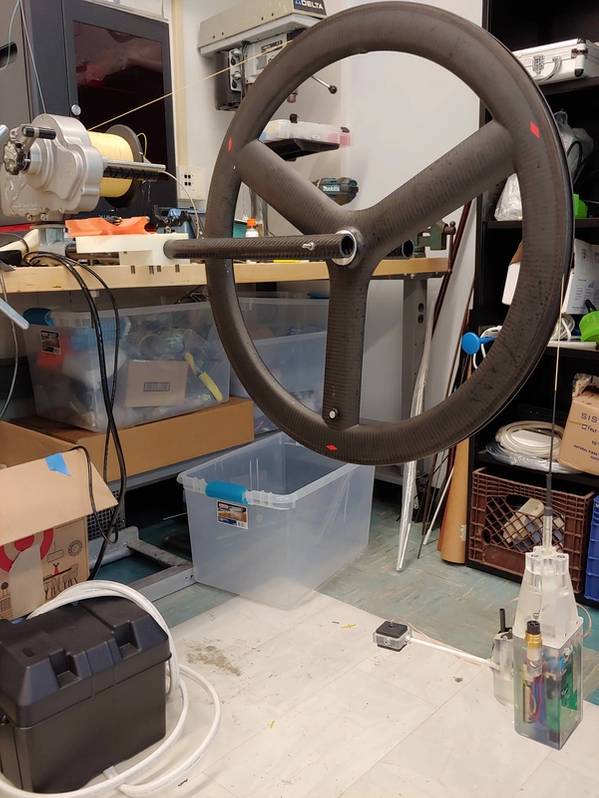 The fiber optic fishing reel system while still under construction in Brennan Phillips’ lab at URI’s Narragansett Bay Campus. Photo courtesy of Brennan Phillips.
The fiber optic fishing reel system while still under construction in Brennan Phillips’ lab at URI’s Narragansett Bay Campus. Photo courtesy of Brennan Phillips. -
- Boreas D90: Digital Fiber-Optic Gyroscope (DFOG) Technology Marine Technology, Apr 2021 #22
.”Specially Designed Coils to make the most of those digital modulation techniques. “Those two things, combined, allow us to detect in-run errors in the fiber optic gyroscope and correct for them, that normally would just be errors in your data in other systems.”An optical chip that combines nine different discrete
-
- Fiber-Optic Connector Technology for O&G Ops Marine Technology, Feb 2017 #22
connectors, which have to withstand pressure differential due to having an atmospheric-pressure internal cavity. Smaller systems benefit from fiber optics. More compact, lighter, highly modular subsea drilling and production systems are the order of the day. They are easier and less expensive to install
-
- AT&T Awarded $157 Million Contract To Build Undersea Fiber-Optic Cable —Color Brochure Available Maritime Reporter, Apr 1991 #20
AT&T has been awarded a $157 million contract to build a new undersea fiber-optic cable that will link the U.S. mainland to Hawaii in 1993. Known as Haw-5, the cable is the fifth to link Hawaii to the mainland and the second fiber-optic cable to do so. The cable, which will carry voice and data
-
- New Buoyant Fiber Optic Cable Marine Technology, Jan 2014 #56
, buoyant cable that has a breaking strength in excess of 2,000 lbs. and a measured density of 1.00g/ml. This cable floats in water. A proven subsea fiber optical cable sold worldwide, STFOCTM serves at the main fiber optic element. www.lindenphotonics.com (As published in the January/February 2014 edition
-
- Multi-channel Fiber Optic System Design: Going Big in Small Packages Marine Technology, Sep 2014 #28
Data channels can be added to fiber optic systems by adding fibers, adding wavelengths, or adding both. Dense wavelength divisional multiplexing (DWDM) allows a single fiber to carry multiple data channels. Passive components, such as optical circulators, double a fiber’s capacity by allowing information to
-
- MTR100 '13 Princetel, Inc. Marine Technology, Jul 2013 #24
[email protected] Website: www.princetel.com CEO/President: Barry Zhang Number of Employees: 33 Princetel manufactures fiber optic rotary joints (fiber optic slip rings) to serve the geophysical industry. The company plays a key role as a supplier of electro-optic coupling devices
-
- Instruments, Computers & Controls Goes Digital Maritime Reporter, Jun 15, 2000 #98
Measuring horsepower, rpm and torque on rotating shafts by utilizing fiber optic sensors, the Digital Torque Meter System, developed by Instruments, Computers & Controls is flexible and highly reliable. Typically holding a NEMA 4 enclosure with shaft hp and rpm displays, the System is also available
-
- The "Wired" Ship Maritime Reporter, Nov 2000 #88
installations, a solution which replaces traditional copper cables and effectively shaves away precious pounds from any ship design. Based on fiber optics, Telenor Fiber has developed communication solutions, sensors and other components for ships and maritime installations. Along with its subsidiary
-
- From Tiny Electrical Impulses Grows a $2.6B Giant MOOG Marine Technology, Jul 2013 #74
Focal came out of the Nova Scotia Research Foundation, its concentration was in a couple of areas, said Glister. One of those areas was the use of fiber optics for marine and subsea applications and its first application was a towed array for the Canadian submarines. The other area was developing an electrical
-
- MTR100: iXBlue Marine Technology, Aug 2015 #74
vessels, fishing, and naval defense. At the heart of an iXBlue INS lies a fiber-optic gyroscope (FOG). A FOG uses optical waves propagating in a fiber optic coil to accurately measure a rotational rate. As a FOG is a completely passive device with no mechanical dithering, sealed cavity or high-voltage
-
- MTR100: Focal Technologies Corporation Marine Technology, Aug 2016 #19
Focal Technologies, a Moog Inc. company, has 32 years experience in the marine industry, specializing in providing electrical slip rings, fiber optic rotary joints, hydraulic utility swivels and fiber optic multiplexer solutions for the worldwide marine industry including ROV, seismic, FPSO turret and
-
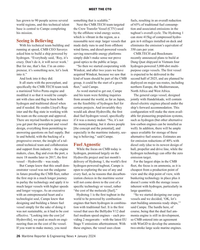 )
January 2024 - Maritime Reporter and Engineering News page: 26
)
January 2024 - Maritime Reporter and Engineering News page: 26MEET THE CTO has grown to 90 people across several something that is scalable.” fuels, resulting in an overall reduction world regions, and this technical talent Next the CMB.TECH team targeted of 65% of traditional fuel consump- base is central to Campe completing the Crew Transfer Vessel (CTV) used
-
 )
December 2023 - Maritime Reporter and Engineering News page: 30
)
December 2023 - Maritime Reporter and Engineering News page: 30,422 tons Flag/Port of registry Japan/Port of Noshiro WIND CHALLENGER SPECIFICATIONS Height Up to about 53 m (4-tier) Width About 15 m Sail material Fiber Reinforced Plastic MOL W IND apanese maritime companies historically have said that Shofu Maru is the result of an eight-year Joint maintained strong
-
 )
September 2023 - Marine Technology Reporter page: 76
)
September 2023 - Marine Technology Reporter page: 76MTR 100 ARCTIC RAYS ARCTIC RAYS in the surveying industry. With partners https://arcticrays.com globally, Sea? oor has a wide range of Arctic Rays specializes in deep-sea vessels and platforms to ? t any job. Its lighting, imaging and surveillance sys- team of engineers and former surveyors tems and
-
 )
September 2023 - Marine Technology Reporter page: 72
)
September 2023 - Marine Technology Reporter page: 72MTR 100 SOUTH BAY CABLE SUBCTECH HOHONU https://southbaycable.com/ www.subctech.com https://www.hohonu.io/ For more than 65 years, South Bay SubCtech offers underwater power so- Hohonu provides actionable real-time Cable has been a leader in custom cable lutions and ocean monitoring systems. data and
-
 )
September 2023 - Marine Technology Reporter page: 50
)
September 2023 - Marine Technology Reporter page: 50MTR 100 Silicon Sensing www.siliconsensing.com Silicon Sensing Systems Ltd is a leader in silicon MEMS gyroscopes, accelerometers and inertial mea- surement systems, focusing on products delivering high performance, ultra-reliability with affordability. The com- pany has supplied more than 25 million
-
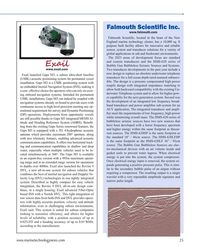 )
September 2023 - Marine Technology Reporter page: 25
)
September 2023 - Marine Technology Reporter page: 25. system. Described as highly compact for easy vehicle integration, the Rovins 9 DVL all-in-one design com- bines, in a single housing, Exail advanced Fiber-Optic based INS with a Nortek DVL. This tight integration of raw sensor data from both INS and DVL provides opera- tors with highly accurate position
-
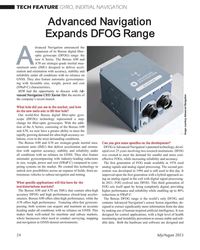 )
July 2023 - Marine Technology Reporter page: 24
)
July 2023 - Marine Technology Reporter page: 24TECH FEATURE GYRO, INERTIAL NAVIGATION Advanced Navigation Expands DFOG Range dvanced Navigation announced the expansion of its Boreas digital ? ber- optic gyroscope (DFOG) range: the new A Series. The Boreas A90 and AA70 are strategic-grade inertial mea- surement units (IMU) designed to deliver
-
 )
May 2023 - Marine Technology Reporter page: 45
)
May 2023 - Marine Technology Reporter page: 45for easy ve- board to provide users with continuous hicle integration, the Rovins 9 DVL all-in-one design combines, in a single housing, Exail advanced Fiber-Optic based INS with a Nortek DVL. This tight integration access to high-level precision meeting any operational requirement for survey of raw sensor
-
 )
May 2023 - Marine Technology Reporter page: 43
)
May 2023 - Marine Technology Reporter page: 43Many aspects of this project are being handled by separate manufacturers and installers, each with expertise relative to the oil and gas sector. The ZMAX-Planova consortium is acting as the integrator, pulling all of this expertise together to deliver a completed network for Petrobras. Of course
-
 )
May 2023 - Marine Technology Reporter page: 42
)
May 2023 - Marine Technology Reporter page: 42CABLING PIONEER CONSULTING ing and permanent reservoirs monitoring. Fiber optic cables branching units with OADM technology to deliver 200 Gb/s also help to create a safer operating environment with a more of bi-directional communications to each cable landing stations connected workforce and more ?
-
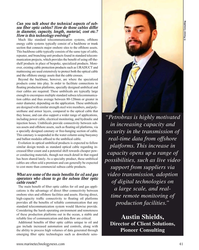 )
May 2023 - Marine Technology Reporter page: 41
)
May 2023 - Marine Technology Reporter page: 41Can you talk about the technical aspects of sub- sea ? ber optic cables? How do these cables differ in diameter, capacity, length, material, cost etc.? How is this technology evolving? © Pioneer Consulting Much like standard telecommunication systems, offshore energy cable systems typically consist of a
-
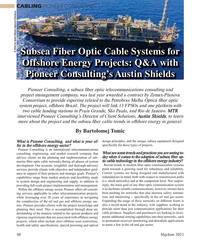 )
May 2023 - Marine Technology Reporter page: 40
)
May 2023 - Marine Technology Reporter page: 40CABLING PIONEER CONSULTING © 2022 by Andre Ribeiro/Agência Petrobras Subsea Fiber Optic Cable Systems for Offshore Energy Projects: Q&A with Pioneer Consulting’s Austin Shields Pioneer Consulting, a subsea ? ber optic telecommunications consulting and project management company, was last year awarded a
-
 )
May 2023 - Marine Technology Reporter page: 38
)
May 2023 - Marine Technology Reporter page: 38ACADEMIA FAU HARBOR BRANCH OCEANOGRAPHIC INSTITUTE While Sullivan misses some aspects of research, he said “I would not trade it for what I can do now, which is facilitate science on a much broader scale for all the scientists here and throughout FAU.” – Jim Sullivan, Executive Director, FAU Harbor
-
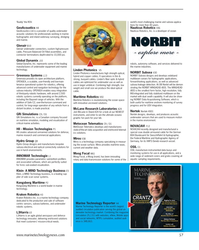 )
March 2023 - Marine Technology Reporter page: 57
)
March 2023 - Marine Technology Reporter page: 57‘Buddy’ the ROV. world’s most challenging marine and subsea applica- tions for more than 40 years. GeoAcoustics Nauticus Robotics H4 V46 GeoAcoustics Ltd is a provider of quality underwater Nauticus Robotics, Inc. is a developer of ocean acoustic solutions for professionals working in marine hydrographi
-
 )
January 2023 - Marine Technology Reporter page: 41
)
January 2023 - Marine Technology Reporter page: 41Tech Files Autonomous Navigation GNSS MEMS Advanced Navigation Advanced Navigation debuts the Boreas D70, a ? ber-optic gyroscope (FOG) iner- tial navigation system (INS). According to the manufacturer, the technology is well suited to surveying, mapping, and navi- gation across subsea, marine, land and
-
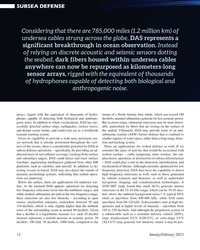 )
January 2023 - Marine Technology Reporter page: 12
)
January 2023 - Marine Technology Reporter page: 12, DAS represents a significant breakthrough in ocean observation. Instead of relying on discrete acoustic and seismic sensors dotting the seabed, dark fibers housed within undersea cables anywhere can now be repurposed as kilometers-long sensor arrays, rigged with the equivalent of thousands of hydrophones
-
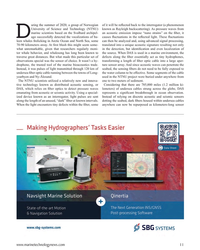 )
January 2023 - Marine Technology Reporter page: 11
)
January 2023 - Marine Technology Reporter page: 11uring the summer of 2020, a group of Norwegian of it will be re? ected back to the interrogator (a phenomenon University of Science and Technology (NTNU) known as Rayleigh backscattering). As pressure waves from marine scientists based on the Svalbard archipel- an acoustic emission impose “nano strains”
-
 )
January 2023 - Marine Technology Reporter page: 5
)
January 2023 - Marine Technology Reporter page: 5THE FUTURE OF FIBER OPTIC GYROSCOPES BOREAS - GNSS / INS 0.005 º Roll & Pitch 0.006 º GNSS Heading 0.01 º Gyrocompass Heading 0.001 º /hr Gyroscope BOREAS st THE WORLD’S 1 DIGITAL FOG Boreas takes FOG technology to the next level with new patent pending digital FOG (DFOG) technology. The revolutionary
-
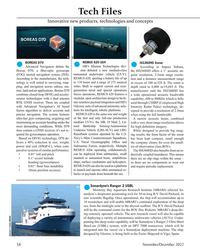 )
November 2022 - Marine Technology Reporter page: 58
)
November 2022 - Marine Technology Reporter page: 58Tech Files Innovative new products, technologies and concepts HII REMUS 620 UUV BOREAS D70 ISS360HD Sonar HII’s Mission Technologies divi- Advanced Navigation debuts the According to Impact Subsea, Boreas D70, a ? ber-optic gyroscope sion debuted a new medium-class the ISS360HD offers a 1° acoustic
-
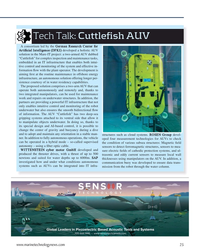 )
September 2022 - Marine Technology Reporter page: 25
)
September 2022 - Marine Technology Reporter page: 25Tech Talk: Cuttlefish AUV Marc/Adobestock A consortium led by the German Research Center for Arti? cial Intelligence (DFKI) developed a holistic AUV solution in the Mare-IT project: a two-armed AUV dubbed “Cuttle? sh” for complex inspection and maintenance tasks, embedded in an IT infrastructure that
-
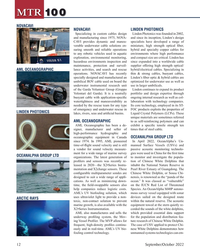 )
September 2022 - Marine Technology Reporter page: 12
)
September 2022 - Marine Technology Reporter page: 12MTR 100 NOVACAVI NOVACAVI LINDEN PHOTONICS Specializing in custom cables design Linden Photonics was founded in 2002, and manufacturing since 1975, NOVA- and since its inception, Linden’s design CAVI provides dynamic and maneu- specialists have developed a range of verable underwater cable solutions en-
-
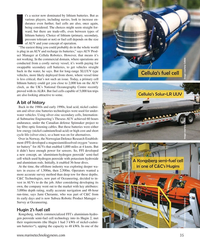 )
July 2022 - Marine Technology Reporter page: 35
)
July 2022 - Marine Technology Reporter page: 35t’s a sector now dominated by lithium batteries. But as various players, including navies, look to increase en- durance even further, fuel cells are also, once again, being considered. The choices might seem straight for- ward, but there are trade-offs, even between types of lithium battery. Choice of
-
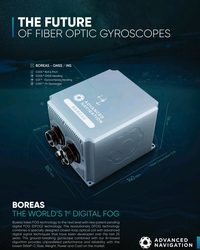 )
July 2022 - Marine Technology Reporter page: 13
)
July 2022 - Marine Technology Reporter page: 13THE FUTURE OF FIBER OPTIC GYROSCOPES BOREAS - GNSS / INS 0.005 º Roll & Pitch 0.006 º GNSS Heading 0.01 º Gyrocompass Heading 0.001 º /hr Gyroscope BOREAS st THE WORLD’S 1 DIGITAL FOG Boreas takes FOG technology to the next level with new patent pending digital FOG (DFOG) technology. The revolutionary
-
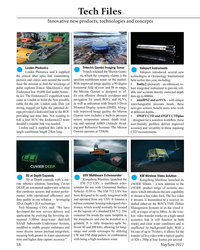 )
May 2022 - Marine Technology Reporter page: 58
)
May 2022 - Marine Technology Reporter page: 58Tech Files Innovative new products, technologies and concepts Tritech’s Gemini Imaging Sonar Linden Photonics Valeport Instruments Tritech released the Micron Gemi- Linden Photonics said it supplied Valeport introduced several new the critical ? ber optic link transmitting ni, which the company claims
